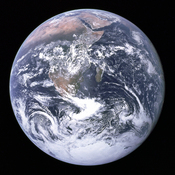The Origin of the Earth
The true origin of the earth is a topic that has been debated for a number of years and there is still not a definite answer.
The most widely accepted theory of today has the earth being formed with the solar nebula model. This model says that our solar system started off as a ball of gasses. The sun and the planets were formed from a ball of gasses that contained 99% hydrogen and helium. There was only about 1% of some of the heavier elements, oxygen, silicon, iron, nickel, and others noble gasses. The huge ball of gasses was spinning, and the force of the spin caused gravity on the gasses. Gravity caused this huge ball of gasses to condense over millions of years. Eventually most of the gasses formed a central body called the proto-sun. It looked like a flat circle with a bulged in the center where the proto-sun was.
Only about 10% of the gasses were left as the atmosphere of the proto-sun. As time passed, gravity caused small balls of gasses to form, this is the formation of early planets. Chemical forces caused the helium and hydrogen to form into small grains (Heinz, 12). Gravity caused these grains to pull together to form large ball and eventually large enough to be a planet.
If you look at the age of the earth as one year, it formed in a week. The early earth consisted of billions and billions of tons of iron, nickel, oxygen and silicon. There was a small amount of aluminum and magnesium. Eventually all of these elements formed into a sphere with a diameter of about 8000 miles. The early earth was gasses, dust particles, and large chunks of solid matter. As all of these were forced...



One pointer
Just a few words to help you better your essays in the future would to put your references in alphabetical order by author's last name. Other than that, not a badly written essay.
2 out of 2 people found this comment useful.